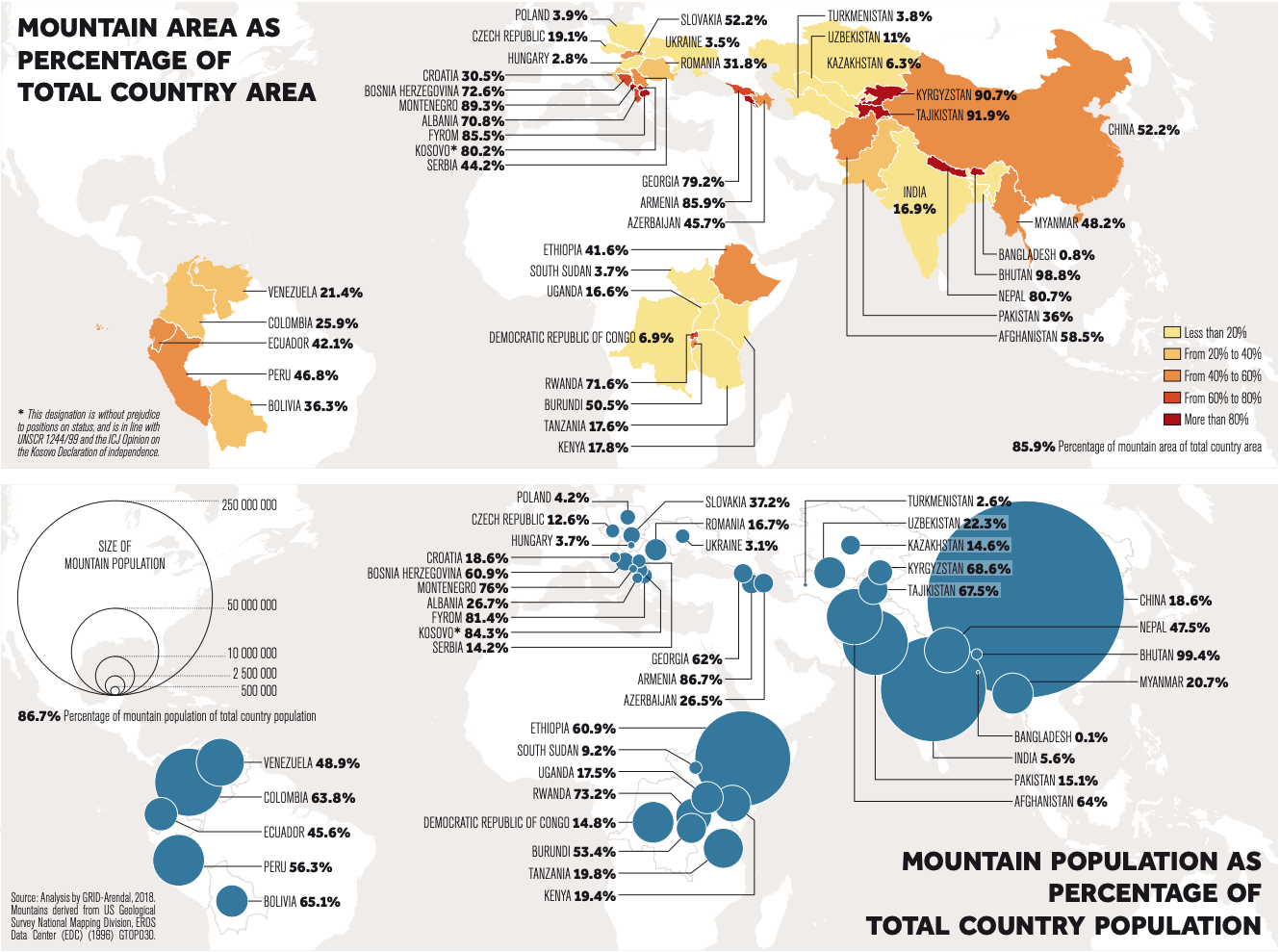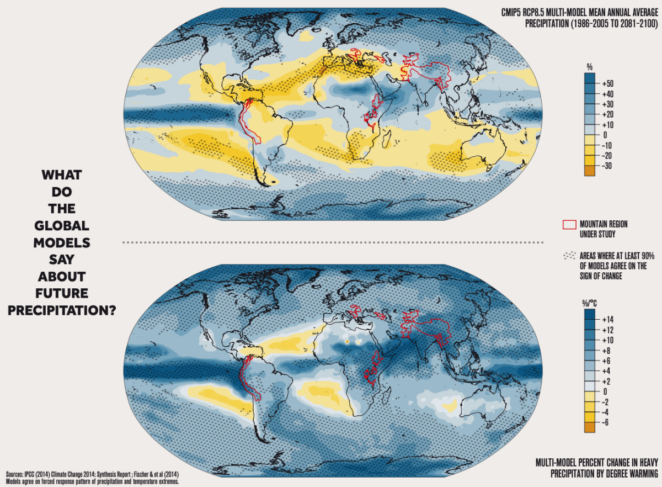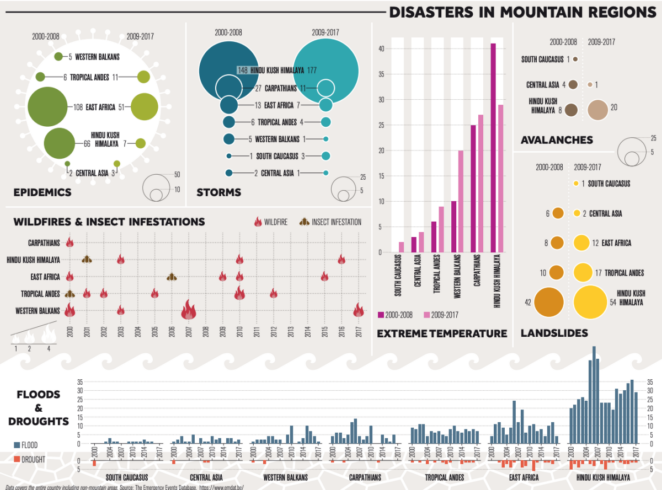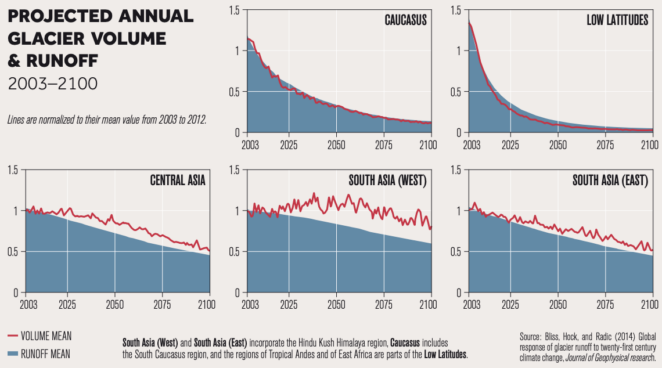Mountain Adaptation Outlook Series: Synthesis Report

Introduction
Mountain regions occupy about one-quarter of the Earth’s land surface, and are home to 15% of the world’s population. The influence of mountains extends far beyond their ranges: they provide goods and services, most notably water, to millions of people downstream.
Many mountain ranges provide natural borders between countries, meaning that they are found on the edge of countries, often away from the centres of power where important decisions are made. Mountain peoples and regions can often – but not always – be marginalized in decision-making, and face lower levels of development.
They are also on the frontline of climate change. Just like the poles, high-altitude areas are warming faster than the global average (a phenomenon known as altitude amplification), and almost all glaciers across mountain regions are retreating. The topography of mountains means they are often steep, with human populations earning a living on precarious land which is prone to flooding, landslides and a host of other climatic and non-climatic hazards. Adaptation to climate change in mountain regions is crucial, not only for the people living in mountains, but also for those living downstream.
This Mountain Adaptation Outlook Series – Synthesis Report* provides a concise summary of the findings of a series of reports focusing on adaptation to climate change in some of the world’s major mountain regions, with a particular focus on developing regions and economies in transition. Those reports, published under the common title of Mountain Adaptation Outlooks, were prepared for the Carpathians (2017), Central Asia (2017), East Africa (2016), Hindu Kush Himalaya (2018), South Caucasus (2015), Tropical Andes (2016) and the Western Balkan mountains (2015). Informed by these Outlooks, this report explores climate change trends and risks for mountain societies, climate change impacts and policy response (including national adaptation policies and sectors), global and regional action on adaptation, and a highlight of project impacts. This Synthesis Report does not include an analysis of policies released after the publication date of each Outlook.
New Reports for 2022
This Outlook Series has been followed by two reports, “Mountains ADAPT: Solutions from East Africa” and “Mountains ADAPT: Solutions from the South Caucasus”. These reports revisit climate change adaptation in East Africa and the South Caucasus, and present successful solutions being implemented in these regions.
Authors: This report was written by Björn Alfthan, Hanna Lønning Gjerdi, Laura Puikkonen, Magnus Andresen, Larisa Semernya, Tina H.P. Schoolmeester, and Matthias Jurek.
*This weADAPT article/case study is an abridged version of the original text by GRID-Arendal and partners, which can be downloaded from the right-hand column. Please access the original text for more detail and figures, and for research purposes, full references, or to quote text.
Background: identifying gaps and opportunities
Between 2015 and 2019, the United Nations Environment Programme (UNEP), in collaboration with GRID-Arendal and a series of partners worked on the project “Climate change action in developing countries with fragile mountainous ecosystems from a sub-regional perspective.” The goal, in a nutshell, was to assist targeted countries and regions to identify existing gaps – and opportunities – to integrate mountain-specific adaptation measures into key sectoral, national and regional development strategies and policies.
The project had three stages:
- Stage 1: The Mountain Adaptation Outlooks.The Mountain Adaptation Outlooks are a series of assessment reports which provide a baseline on climate change impacts, vulnerabilities and existing policies in each of the regions. Each of these Outlooks follows a similar format and methodology. A second round of Outlooks will be published from 2022.
- Stage 2: Sub-regional policy dialogues.A series of policy dialogues were undertaken involved key designated governmental and non-governmental stakeholders and experts on climate change and sustainable mountain development from the various countries. At each policy dialogue, a series of guidance documents were prepared based on the Outlooks, stakeholder consultations and other sources.
- Stage 3: Follow-up actions at the sub-regional and national level.Both the sub-regional consultation meetings and Outlook process helped provide feedback and ideas for concrete follow-up actions at the national and regional level to address the specific needs of the countries.
Climate Change Trends and Risks for Mountain Societies
Trends
Warming: According to the data presented in the various Outlooks, average annual temperatures have increased across all mountain regions and within all countries. Projections for all mountain regions and countries indicate that the warming trend will continue.

Precipitation: The pattern of past precipitation change in mountain regions has not been as consistent as for past temperature patterns. All mountain regions have experienced changing rainfall seasonality and/or rainfall intensity in one form or another, even if annual rainfall has not changed. Future projections of precipitation are also less clear. Precipitation is expected to decrease in the Western Balkans, and increase in East Africa, Central Asia and the Hindu Kush Himalaya, while no large annual change is expected at all in the Andes. In the Carpathians and South Caucasus precipitation is expected to have mixed trends, including less rainfall during summer and more during winter.

Risks
The risk of climate-related impacts results from the interaction of climate-related hazards with the vulnerability and exposure of human and natural systems. Mountains are generally hazardous places, even under conditions of natural climate variability. Events can unleash “fast-onset” hazards such as landslides, floods, and avalanches, the types of hazards that usually receive the most attention, while “slow-onset” hazards in mountains include increasing temperatures (the rate of which is increasing faster at higher altitudes), reduced precipitation, desertification, changes in ecosystems and melting glaciers.
Socio-economic processes determine vulnerability and exposure to risk. Mountain societies are distributed across different countries and continents, within often starkly varied physical and socio-economic settings. However, there are several commonalities, often termed “mountain specificities”, which explain why mountain regions face similar impacts from climate change. Many mountain regions are challenged by similar socio-economic factors which contribute to vulnerability and exposure: isolated populations; poor and costly access to markets; poor infrastructure; more widespread poverty and food insecurity; lower education levels; a lack of diversification of livelihoods, including a high dependence on agriculture as the main or only source of livelihood; and marginalization in decision making.
Mountain societies have adapted to an already harsh – and changing – climate over hundreds if not thousands of years. However, the rapid and unprecedented rate of climate change now is challenging this adaptive capacity, as is evident through the already widespread impacts being felt across mountain regions.

Policy Recommendations by Sector
Water
- As water is a highly transboundary issue, regional cooperation should be a priority in mountain regions with an emphasis on hydrological data sharing (including groundwater aquifers) and the development of flood early-warning/forecasting systems.
- Given that water availability is expected to become more unpredictable, innovative water management and storage solutions should be explored, particularly in areas prone to drought. Furthermore, solutions should be designed to capitalise on times of plentiful / “too much” water. In parallel, improvements in water efficiency are needed given that water demand is likely to further increase.

Agriculture and Food
- Promote climate-smart agriculture including improved water management and irrigation systems, agrobiodiversity and the use of resilient crop varieties. Best practises should be shared at all levels including between regions, as many mountain areas face similar challenges.
- Enhance the understanding of climate change impacts and associated risks on mountain agriculture and food security, which can inform the development of appropriate policies and risk-sharing and risk-transfer mechanisms (e.g. weather-indexed insurance).
Forests, Ecosystems, and Biodiversity
- Projected species range and vegetation shifts, possible increases in human-wildlife conflict and other climate-related impacts call for adaptive management of national and regional protected area networks.
- Mainstream climate change adaptation into forestry practises and policies, including the establishment of mechanisms for monitoring climate impacts (e.g. fire detection, soil degradation).
- Promote ecosystem-based adaptation, which includes a range of low-cost options that promote sustainable management of natural resources while planning for and adapting to changing climate conditions.
Infrastructure and Energy
- With a projected increase in the development of hydropower production in many mountain regions, it is essential that policies, plans and development projects consider changing hydrological regimes, extreme climate events, and possible ecological impacts.
- Infrastructure development across mountain regions should consider the projected impacts of climate change, for example by integrating vulnerability assessments into land-use planning and the timely sharing of information on potential risk zones.
Human Health
- Climate change-related impacts on human health, and the consideration of mountain-specific vulnerabilities, need to be integrated in health policies as they are largely absent.
- The inaccessibility of many mountain communities, limited infrastructure and inadequate access to health care services, makes it urgent for policies to consider how projected climate change impact may affect human health in these areas.
Tourism
- While many countries seek to promote mountain tourism further, there is a great need to develop strategies that consider the risks of extreme events, and to put in place policies and regulations that promote the safety of tourists and the industry itself. This is especially important in areas with limited infrastructure and inaccessibility, such as high mountain areas.
- The tourism sector is closely interlinked with other sectors such as infrastructure, energy, water and human health, and adverse impacts on these will also affect tourism. There is thus a great need to generate more attention to the linkages and inter-dependencies between sectors.

From Knowledge to Action – a Highlight of Project Impacts
The purpose of developing the Adaptation Outlooks for the respective mountain regions has been to provide a baseline on key risks and impacts of climate change, both current and projected, on important sectors in mountain regions, and to identify key gaps in policies and provide prioritised actions for climate change adaptation in mountain ecosystems.
The text also highlights some of the efforts by UNEP and partners to foster regional dialogue and cooperation and both regional and national action on climate change adaptation. These follow two key approaches:
Enhancing regional cooperation through policy dialogues: UNEP has been working with partners, including national governments, in the respective regions to promote regional cooperation on adaptation to climate change in mountain regions. Regional meetings were organised in all mountain regions covered in this report to stimulate discussions towards a shared joint vision for climate change and adaptation in mountain ecosystems. The outcome has been a series of regional agendas on climate change adaptation that have either been endorsed by governments at highest level, or are in development. See the full text for examples.
Adaptation actions within mountain countries targeting specific sectors: The consultation meetings and policy dialogues, combined with the Adaptation Outlooks, laid the ground for follow up activities on climate change adaptation targeting specific sectors for action, with the political support of countries. These follow up activities have focussed on building the capacities, from national governments to municipalities, to both understand the nature of the projected impacts of climate change and existing vulnerabilities, and put in place adequate adaptation plans and activities.
Many of the Outlooks identified the need – and opportunity – for managing ecosystems in ways that can help communities and mountain societies to adapt to climate change, especially applying Ecosystem-based Adaptation approaches. At the same time, the Outlooks also revealed that climate change is impacting mountain ecosystems themselves, increasing human-wildlife conflict in certain areas and rendering existing protected area networks unsuitable or ineffective.
A substantial follow-up initiative has been the “Vanishing Treasures” project, financed by the Government of Luxembourg, focusing on the Virunga (Uganda, Rwanda), Hindu Kush Himalaya (Bhutan), and Central Asia (Kyrgyzstan, Tajikistan) mountain ranges.
UNEP and GRID-Arendal, together with partners, publish in 2022 under the Adaptation at Altitude programme regional “Mountains ADAPT” booklets with concrete innovative adaptation solutions from East Africa and the South Caucasus . The new knowledge products largely capitalize on the Mountain Adaptation Outlook series.
Suggested Citation
Alfthan, B., Gjerdi, H.L., Puikkonen, L., Andresen, M., Semernya, L., Schoolmeester, T., Jurek, M. (2018). Mountain Adaptation Outlook Series – Synthesis Report. United Nations Environment Programme, and GRID-Arendal, Nairobi, Vienna, and Arendal. www.unenvironment.org, www.grida.no
Related reading
Related projects
Related events
- A FRAGILE FUTURE: Can mountain communities adapt to climate change?
- Upscaling adaptation solutions for vulnerable mountain regions through international cooperation
- Promoting ambitious climate action for the Hindu Kush Himalaya
- Climate change and forced migration in mountain areas: What are the solutions?
- Managing disaster risks and water under climate change in Central Asia and Caucasus
- Current state of climate change policies and adaptation strategies in the Andes: A multi-sectoral view from the mountains
- The Hindu Kush Himalaya Assessment: Mountains, Climate Change, Sustainability and People

Comments
There is no content